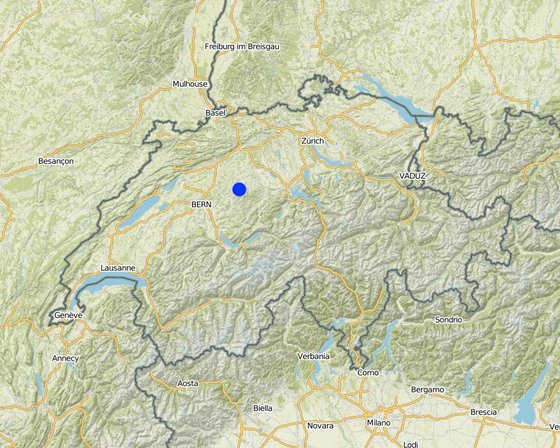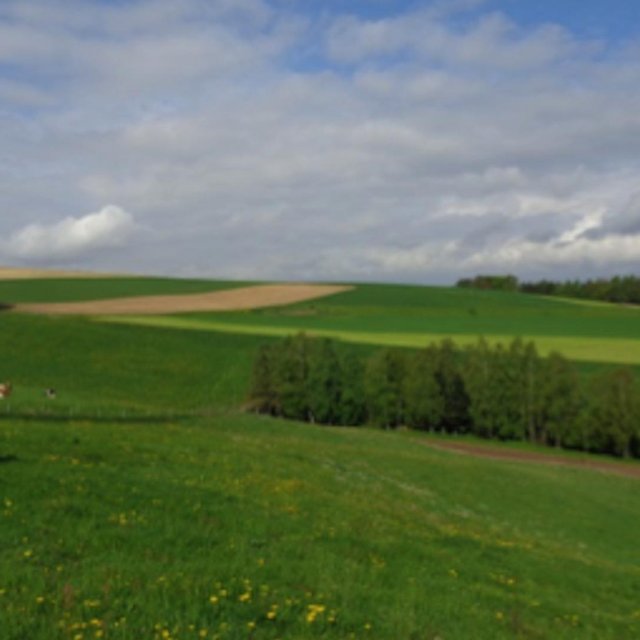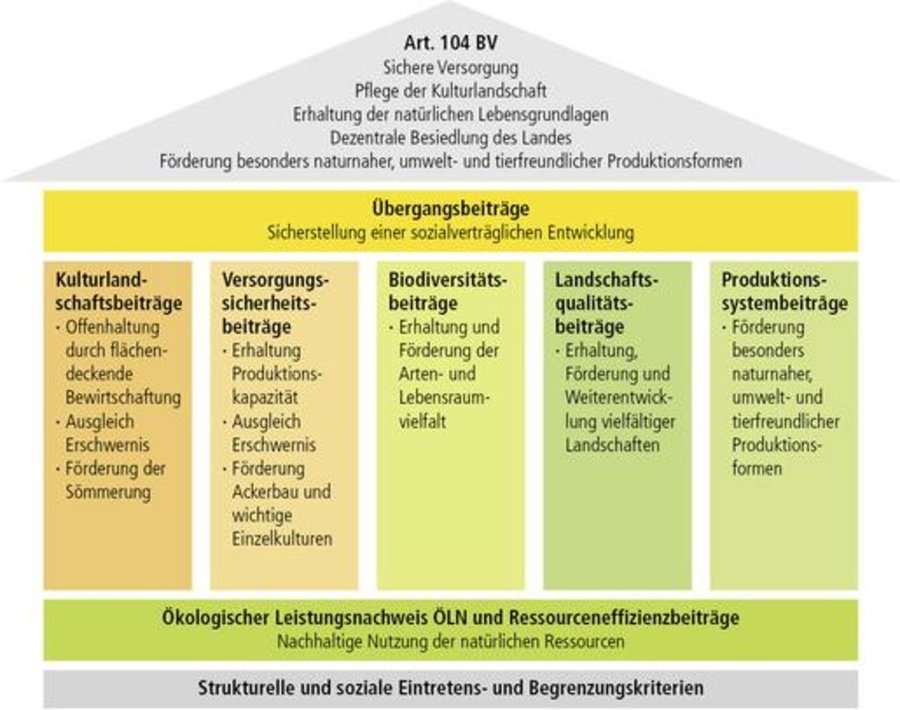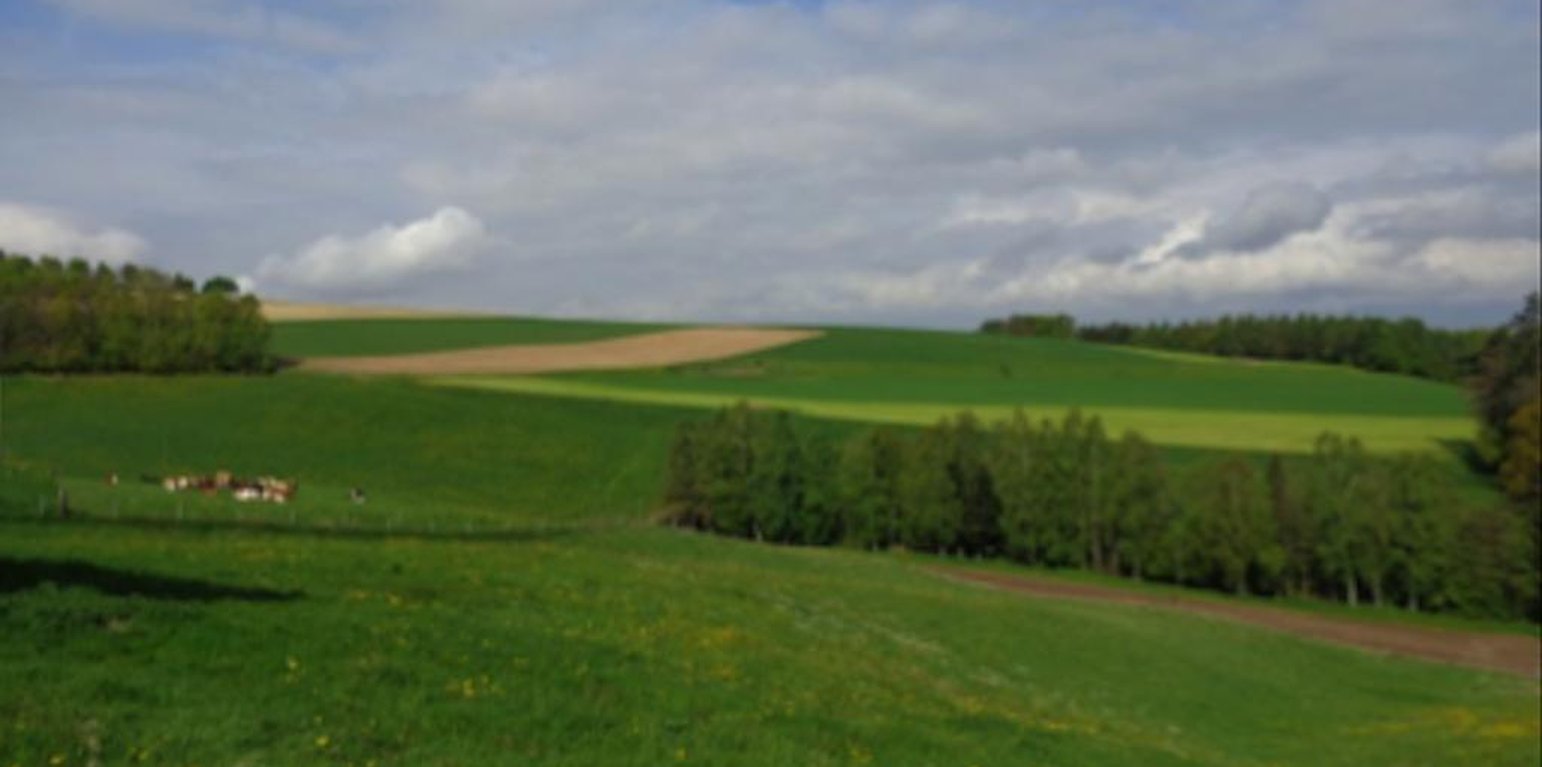Direct Payment System
(Швейцар)
Direktzahlungssystem
Тодорхойлолт
Financial aid of the government to land users to compensate for loss of financial output of crops.
Aims / objectives: The main aim is to maintain agriculture and its production of goods. Because of the small amount of financial output for a land user and its products in Switzerland, there are direct payments to the land user paid per area size. These payments are substantial for every land user but especially in mountain regions of Switzerland to compensate land users for their work for nature and environment. Another goal is to keep the nutrient security of Switzerland alive. This goal can only be reached by supplementary payments in order to produce agricultural goods competitively.
Methods: Direct payments mean financial sums paid to a land user per area size. They differ from position of the field. A land user must apply for the direct payments in autumn. During winter the land user must mark his fields and their use online. Payments are reached three times during the following year: in June, autumn and winter.
Stages of implementation: The beginning of direct payments is in the 1980s when there were payments for livestock owners. Before there were never direct financial payments to land users but the agricultural products were financed by the government itself and land users got a fixed price for their products. 1989 land users got direct payments for the first time under the programs IP Suisse and ÖLN. Today payments are calculated by area size.
Role of stakeholders: The direct payment system is mainly a political issue. Politicians make budgets for the total amount of direct payments each year. Moreover, they can make new rules and obligations for land users. The land user must always adopt himself and his technology and crop rotation to these changes. This can be very difficult. Land users are represented by their unions but there is no space for individual opinions or direct participation in the system.
Байршил

Байршил: Frienisberg, Bern, Швейцар
Сонгосон байршлуудын газарзүйн холболт
Эхлэх огноо: 1989
Төгсөх жил: тодорхойгүй
Арга барилын төрөл
-
уламжлалт / уугуул
-
Сүүлийн үеийн орон нутгийн санаачлага / шинэчлэл
-
төсөл / хөтөлбөр дээр үндэслэсэн

-
Арга барилын зорилго ба эерэг нөлөө
Арга барилын үндсэн зорилго, зорилт
The Approach focused mainly on SLM with other activities (Maintenance of a good financial situation for Swiss land users)
The system wants to support Swiss Agriculture on a financial basis. Because agricultural products are produced under swiss conditions regarding wages, soil prices etc. the products can not compete against other products from abroad. The direct payments close the gap between the theoretical value of a product and its end price in stores.
The SLM Approach addressed the following problems: The system of direct payments gives wrong appeals to the land users. Because payments are made by area size land users want to expand their farm size even more. But there is also more work to do if a farm is bigger. The system also provokes cultivation of fields that are at risk for erosion or other consequences because it does not differ from fields that are at risk and fields that are not. It is only the size that matters.
Тухайн Арга барилын хүрээнд нэвтрүүлсэн Технологийг хэрэгжүүлэхэд дэмжлэг болох нөхцлүүд
Тухайн Арга барилын хүрээнд нэвтрүүлсэн Технологийг хэрэгжүүлэхэд хүндрэл учруулах нөхцлүүд
-
Санхүүгийн нөөц, үйлчилгээний хүртээмж / боломж: Rentability of conservational agriculture and its technologies were often discussed because there may be losses at the beginning.
Treatment through the SLM Approach: Because of financial payments losses of financial capital can be compensated.
Талуудын оролцоо ба үүрэг
Арга барилд оролцогч талууд болон тэдгээрийн үүрэг
| Ямар оролцогч талууд / хэрэгжүүлэгч байгууллагууд арга барилд оролцож байсан бэ? |
Оролцогч талуудыг тодорхойлно уу |
Оролцогч талуудын үүргийг тайлбарлана уу |
| Орон нутгийн газар ашиглагч / орон нутгийн иргэд |
|
|
| ТББ |
|
|
| Орон нутгийн захиргаа |
|
|
| Засгийн газар (шийдвэр гаргагч, төлөвлөгч) |
|
|
Тэргүүлэх байгууллага
government
Арга барилын янз бүрийн үе шатанд орон нутгийн газар ашиглагчид / бүлгүүдийг татан оролцуулах
үгүй
идэвхигүй
Гадаад дэмжлэг
интерактив
өөрийн хүчийг нэгтгэсэн
Арга барил хэрэгжүүлэх бүдүүвч
Organisation chart for direct payments

Зохиогч: BLW
ГТМ-ийн технологи сонгох шийдвэр гаргах явц
Шийдвэр гаргасан этгээд
-
Газар ашиглагч дангаараа (өөрийн санаачлага)
-
ГТМ-ийн мэргэжилтнүүдийн дэмжлэгтэйгээр, голчлон газар ашиглагчид
-
оролцооны зарчмын хэсэг болох бүх холбогдох талууд
-
голдуу ГТМ-ийн мэргэжилтнүүд, газар ашиглагчидтай зөвлөлдсөний үндсэн дээр
-
ГТМ-ийн мэргэжилтэн дангаараа
-
улс төрчид / удирдагчид
Шийдвэр гаргах үндэслэл нь
-
ГТМ-ийн мэдлэгийг баримтжуулалтын үнэлгээ (нотолгоонд суурилсан шийдвэр гаргах)
-
Судалгааны үр дүн, ололтууд
-
Хувь хүний туршлага ба санал бодол (баримтжуулаагүй)
Техникийн туслалцаа, чадавхи бий болгох болон мэдлэгийн менежмент
Дараах үйл ажиллагаа эсвэл үйлчилгээ нь арга барилын нэг хэсэг болсон
-
Чадавхи бэхжүүлэх/сургалт
-
Зөвлөх үйлчилгээ
-
Институцийг бэхжүүлэх (байгууллагын хөгжил)
-
Мониторинг ба үнэлгээ
-
Судалгаа
Чадавхи бэхжүүлэх / сургалт
Дараах сонирхогч талуудад сургалт хийсэн
-
Газар ашиглагчид
-
хээрийн ажилтан / зөвлөх
Сургалтын хэлбэр
-
Ажил дээр
-
фермерээс -фермер
-
үзүүлэнгийн талбай
-
Олон нийтийн уулзалт
-
курс дамжаа
Хамарсан сэдэв
There was also an overthinking on the side of land users. Some of them did not change environmentally good technologies after there were less payments for this technology because they saw the advantages of their technology. However, without a financial support at the beginning they would not have implemented new technologies.
Зөвлөх үйлчилгээ
Зөвлөх үйлчилгээ үзүүлсэн
-
Газар ашиглагчийн талбай дээр
-
Тогтмол төвд
Advisory service is very adequate to ensure the continuation of land conservation activities
Мониторинг ба үнэлгээ
bio-physical aspects were ad hoc monitored by government through observations; indicators: None
socio-cultural aspects were ad hoc monitored by government through observations; indicators: None
economic / production aspects were ad hoc monitored by government through observations; indicators: None
area treated aspects were ad hoc monitored by government through observations; indicators: None
no. of land users involved aspects were ad hoc monitored by government through measurements; indicators: None
management of Approach aspects were ad hoc monitored by None through observations; indicators: None
There were few changes in the Approach as a result of monitoring and evaluation: None
There were few changes in the Technology as a result of monitoring and evaluation: None
Судалгаа
Судалгаа нь дараах сэдвийг хамарсан
-
Социологи
-
Эдийн засаг/ зах зээл
-
Экологи
-
Технологи
Research was carried out on station
Санхүүжилт болон хөндлөнгийн материаллаг дэмжлэг
ГТМ-ийн бүрэлдэхүүн хэсгийн жилийн төсөв ам.доллараар
-
< 2,000
-
2,000-10,000
-
10,000-100,000
-
100,000-1,000,000
-
> 1,000,000
Precise annual budget: тодорхойгүй
Approach costs were met by the following donors: government (projects): 50.0%; national non-government (soil support program): 10.0%; local government (district, county, municipality, village etc): 40.0%
Газар ашиглагч нарт дараах урамшуулал, үйлчилгээг үзүүлсэн
-
Газар ашиглагчдад санхүүгийн / материаллаг дэмжлэг үзүүлсэн
-
Тодорхой хөрөнгө оруулалтанд нөхөн олговор олгох
-
Кредит
-
Бусад урамшуулал, хэрэгсэл
Газар ашиглагчдад санхүүгийн болон материаллаг дэмжлэг үзүүлэх
хэсэгчлэн санхүүждэг
Бүрэн санхүүждэг
Хөдөө аж ахуй: Үр, үрсэлгээ
area size
cultivation per ha
Газар ашиглагчаас гаргасан хөдөлмөр хүчний зардал
-
сайн дурын
-
хоол хүнсээр ажилладаг
-
бэлэн мөнгөөр төлдөг
-
бусад материаллаг дэмжлэгээр шагнагдсан
Нөлөөллийн дүн шинжилгээ ба дүгнэлт
Арга барилын үр нөлөө
Үгүй
Тийм, бага зэрэг
Тийм, зарим
Тийм, их
Арга барил нь ГТМ-ийн технологийг хэрэгжүүлж, хадгалахад газар ашиглагчдад тусласан уу?
There are payments for conservational agriculture and technologies. Therefore, SLM is applied there. However, there are also payments for conventional agriculture and technologies and the attractiveness to change a cultivation system is not very high.
Did other land users / projects adopt the Approach?
about 97%
Газар ашиглагчид ГТМ хэрэгжүүлэх болсон үндсэн шалтгаан
-
үйлдвэрлэл нэмэгдсэн
-
Ашиг нэмэгдсэн (боломж), зардал-үр ашгийн харьцаа сайжирсан
-
Газрын доройтол буурсан
-
Гамшигийн эрсдэл буурсан
-
Ажлын ачаалал бууруулсан
-
төлбөр / татаас
-
дүрэм журам (торгууль) / сахиулах
-
нэр хүнд, нийгмийн дарамт / нийгмийн холбоо
-
Сүлжээ/ бүлэг төсөл/ хөдөлгөөнд гишүүнээр элсүүлэх
-
Байгаль орчны ухамсар
-
зан заншил, ёс суртахуун
-
ГТМ-ийн мэдлэг, туршлага дээшилсэн
-
гоо зүйн сайжруулалт
-
зөрчилдөөнийг бууруулах
Арга барилын хүрээнд хэрэгжүүлсэн үйл ажиллагааны тогтвортой байдал
Газар ашиглагчид арга барилаар дамжуулан хэрэгжүүлсэн арга хэмжээг тогтвортой үргэлжлүүлж чадах уу (гадны дэмжлэггүйгээр)?
Дүгнэлт, сургамж
Давуу тал: газар ашиглагчийн бодлоор
-
The payments are a security of income for the land users. Therefore he continues his production of agricultural products. (How to sustain/ enhance this strength: The payment must be enough high so that it is accurate for the labour and work of a land user on the fields. This must also be a point regarding future payments.)
Давуу тал: эмхэтгэгч эсвэл бусад мэдээлэл өгсөн хүмүүсийн бодлоор
-
It is a fair system: a land user only gets paid for his work on a field. (How to sustain/ enhance this strength: A good life for a land user and his family is possible through the financial aid of the direct payment system. This must be maintained.)
Сул тал/ дутагдал / эрсдэл: газар ашиглагчийн бодлоордаван туулах боломжууд
-
A fixed product price would be the solution to higher payments. The situation from the beginning of the system was much better.
Product prices must be on a similar level. However, this is not possible.
Сул тал/ дутагдал / эрсдэл: эмхэтгэгч эсвэл бусад мэдээлэл өгсөн хүмүүсийн бодлоордаван туулах боломжууд
-
The system provides some dependence for the land user. He can not produce competitively without supplementary payments.
Fair product prices and competitiveness would be the solution, but this is impossible to reach.
-
There are many differences during short time regarding the sum and conditions of direct payments. A land user has thereby no chance of adopting himself to the new conditions.
Payments must be stable during a longer time. Only then a land user is able to change his cultivation system.
-
The system leads to wrong cultivation of fields because a land user wants as much area size as possible. This endangers soil and can lead to erosion.
The system should be reduced to only not-endangered fields and provide payments for the non-cultivation of endangered fields.
Суурь мэдээлэлүүд
Баримтжуулсан огноо: 30 6-р сар 2015
Сүүлийн шинэчлэл: 07 7-р сар 2017
Мэдээлэл өгсөн хүн
-
Deborah Niggli (deborah.niggli@cde.unibe.ch) - ГТМ мэргэжилтэн
WOCAT мэдээллийн сан дахь бүрэн тодорхойлолт
Баримтжуулалтыг зохион байгуулсан
Байгууллага
- CDE Centre for Development and Environment (CDE Centre for Development and Environment) - Швейцар
Төсөл
- Preventing and Remediating degradation of soils in Europe through Land Care (EU-RECARE )






